HONDA ACCORD HYBRID 2014 9.G User Guide
Manufacturer: HONDA, Model Year: 2014, Model line: ACCORD HYBRID, Model: HONDA ACCORD HYBRID 2014 9.GPages: 561, PDF Size: 20.3 MB
Page 11 of 561
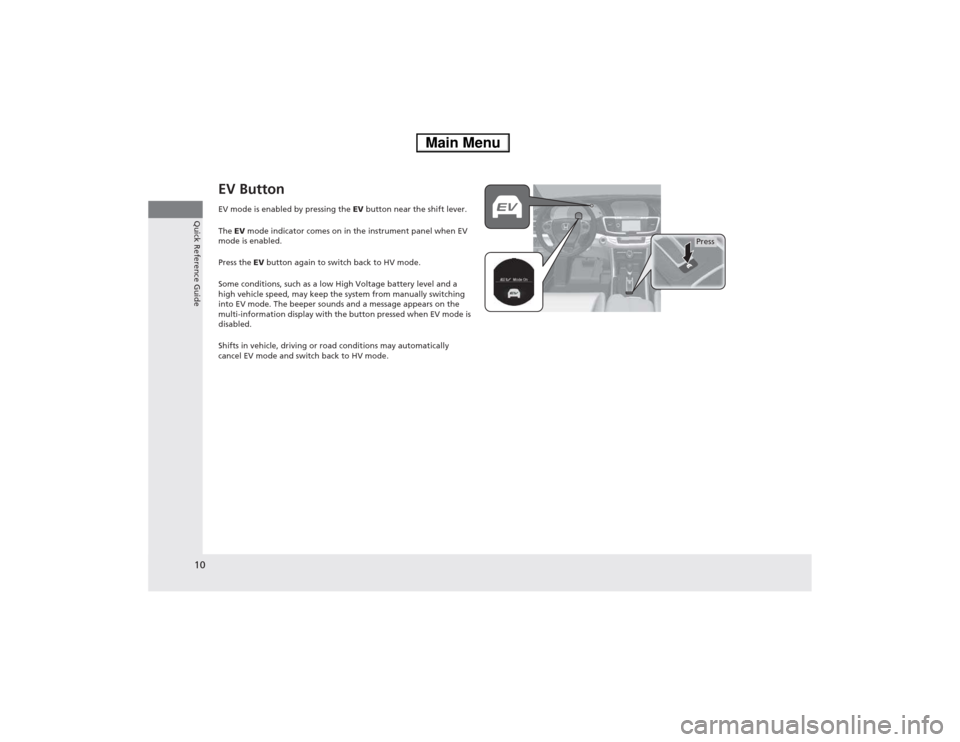
10
Quick Reference Guide
EV Button
EV mode is enabled by pressing the EV button near the shift lever.
The EV mode indicator comes on in the instrument panel when EV
mode is enabled.
Press the EV button again to switch back to HV mode.
Some conditions, such as a low High Voltage battery level and a
high vehicle speed, may keep the system from manually switching
into EV mode. The beeper sounds and a message appears on the
multi-information display with the button pressed when EV mode is
disabled.
Shifts in vehicle, driving or road conditions may automatically
cancel EV mode and switch back to HV mode.
Press
Main Menu
Page 12 of 561
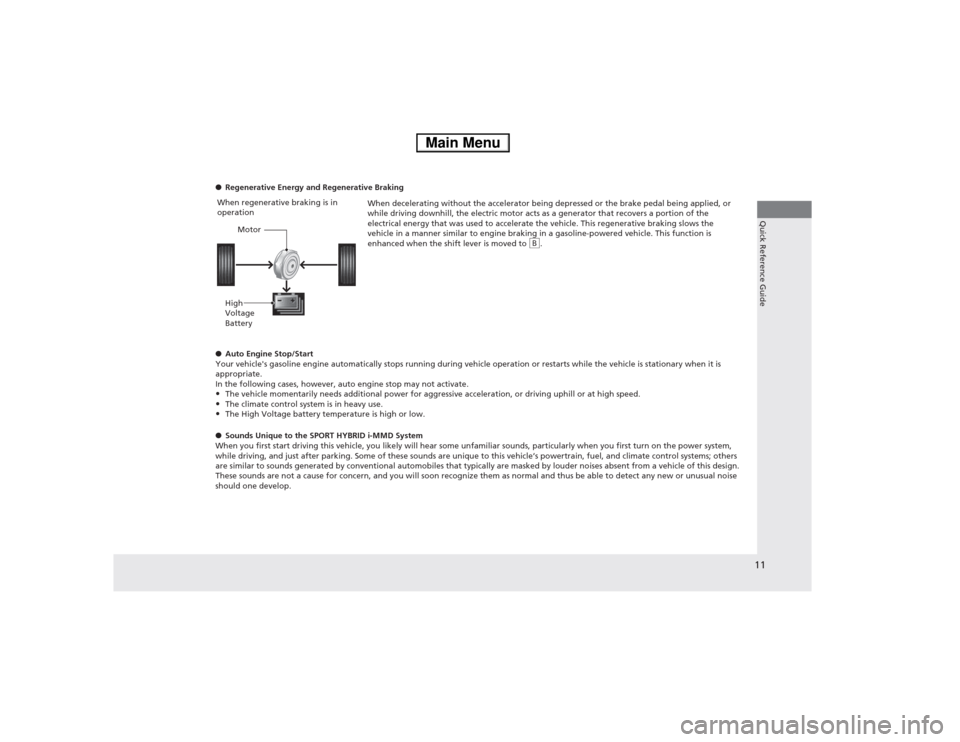
11
Quick Reference Guide
●Regenerative Energy and Regenerative Braking
When decelerating without the accelerator being depressed or the brake pedal being applied, or
while driving downhill, the electric motor acts as a generator that recovers a portion of the
electrical energy that was used to accelerate th e vehicle. This regenerative braking slows the
vehicle in a manner similar to engine braking in a gasoline-powered vehicle. This function is
enhanced when the shift lever is moved to .
● Auto Engine Stop/Start
Your vehicle's gasoline engine automatically stops running during vehicle operation or restarts while the vehicle is stationary when it is
appropriate.
In the following cases, however, auto engine stop may not activate.
• The vehicle momentarily needs additional power for aggressive acceleration, or driving uphill or at high speed.
• The climate control system is in heavy use.
• The High Voltage battery temperature is high or low.
● Sounds Unique to the SPORT HYBRID i-MMD System
When you first start driving this vehicle, you likely will hear some unfamiliar sounds, particularly when you first turn on the power system,
while driving, and just after parking. Some of these sounds are unique to this vehicle
Page 13 of 561
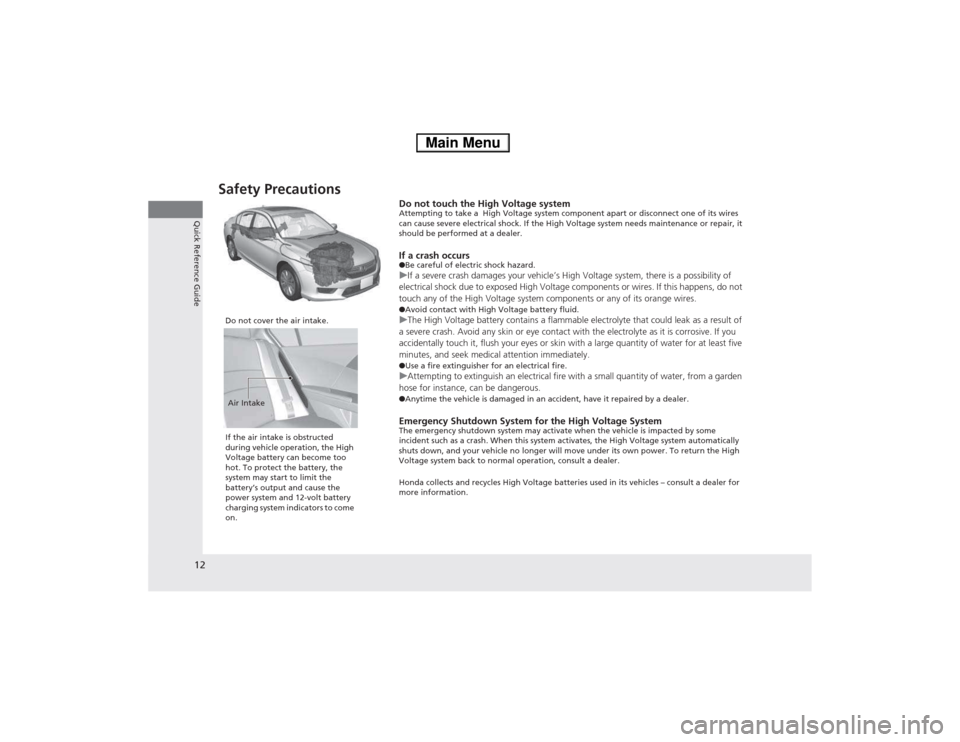
12
Quick Reference Guide
Safety PrecautionsDo not touch the High Voltage system
Attempting to take a High Voltage system component apart or disconnect one of its wires
can cause severe electrical shock. If the High Voltage system needs maintenance or repair, it
should be performed at a dealer. If a crash occurs ● Be careful of electric shock hazard.
uIf a severe crash damages your vehicle’s High Voltage system, there is a possibility of
electrical shock due to exposed High Voltage components or wires. If this happens, do not
touch any of the High Voltage system components or any of its orange wires. ● Avoid contact with High Voltage battery fluid.
uThe High Voltage battery contains a flammable electrolyte that could leak as a result of
a severe crash. Avoid any skin or eye contact with the electrolyte as it is corrosive. If you
accidentally touch it, flush your eyes or skin with a large quantity of water for at least five
minutes, and seek medical attention immediately. ● Use a fire extinguisher for an electrical fire.
uAttempting to extinguish an electrical fire with a small quantity of water, from a garden
hose for instance, can be dangerous. ● Anytime the vehicle is damaged in an accident, have it repaired by a dealer.
Emergency Shutdown System for the High Voltage System
The emergency shutdown system may activate when the vehicle is impacted by some
incident such as a crash. When this system activate s, the High Voltage system automatically
shuts down, and your vehicle no longer will move under its own power. To return the High
Voltage system back to normal operation, consult a dealer.
Honda collects and recycles High Voltage batt eries used in its vehicles – consult a dealer for
more information.
Do not cover the air intake.
If the air intake is obstructed
during vehicle operation, the High
Voltage battery can become too
hot. To protect the battery, the
system may start to limit the
battery’s output and cause the
power system and 12-volt battery
charging system indicators to come
on. Air Intake
Main Menu
Page 14 of 561
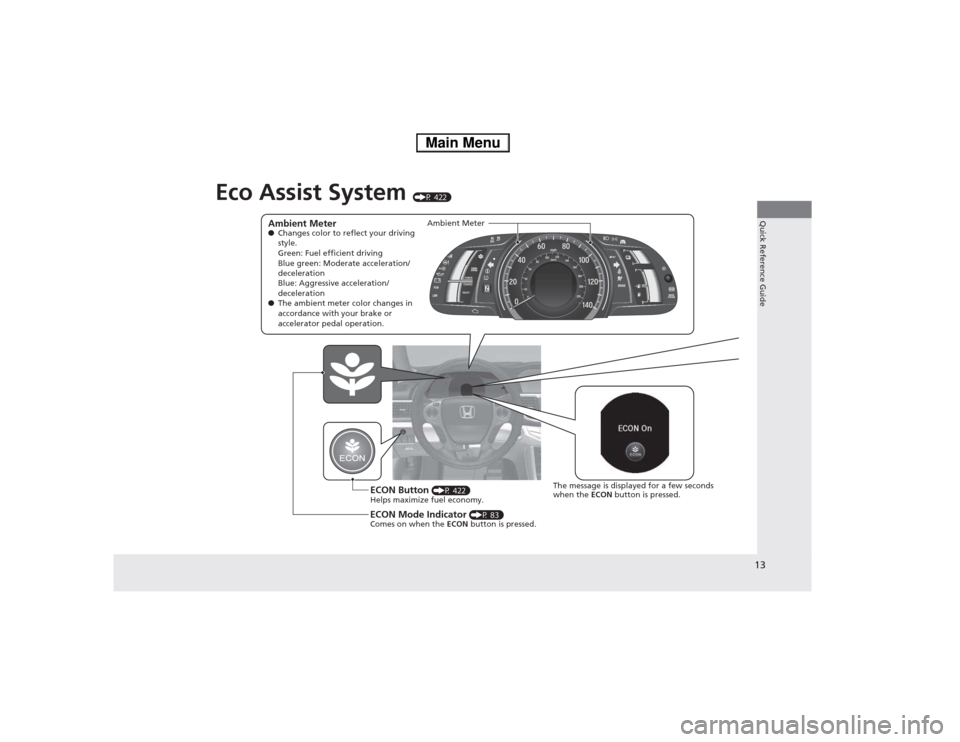
13
Quick Reference Guide
Eco Assist System (P 422)
Ambient Meter ●Changes color to reflect your driving
style.
Green: Fuel efficient driving
Blue green: Moderate acceleration/
deceleration
Blue: Aggressive acceleration/
deceleration
● The ambient meter color changes in
accordance with your brake or
accelerator pedal operation.
ECON Button (P 422)
Helps maximize fuel economy.
ECON Mode Indicator (P 83)
Comes on when the ECON button is pressed.
The message is displayed for a few seconds when the ECON button is pressed.
Ambient Meter
Main Menu
Page 15 of 561
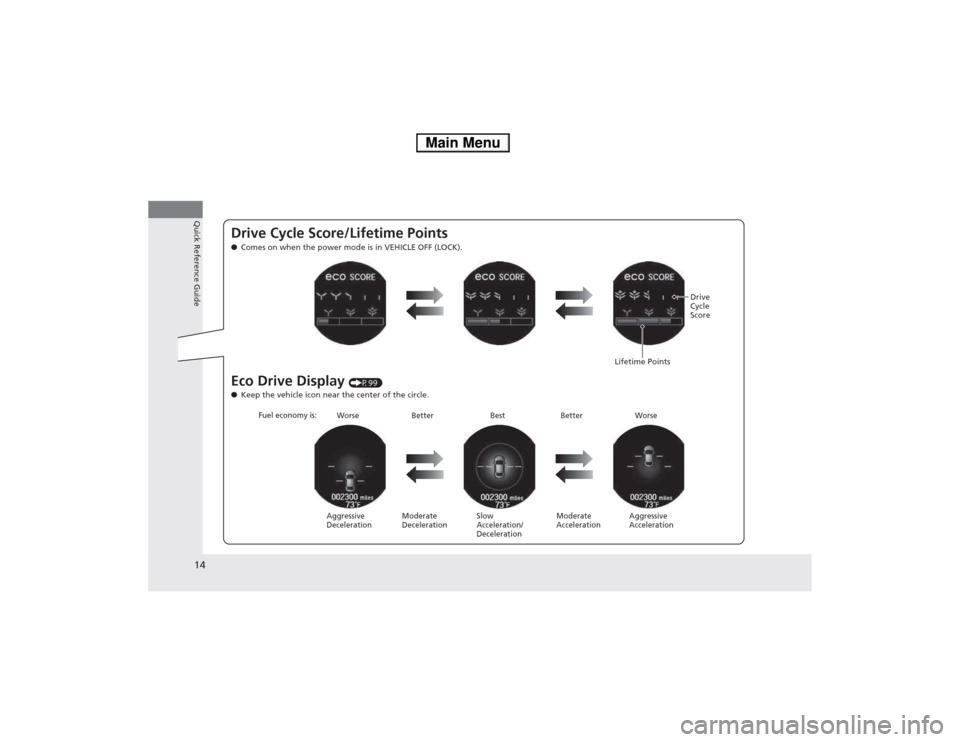
14
Quick Reference Guide
Drive Cycle Score/Lifetime Points ●Comes on when the power mode is in VEHICLE OFF (LOCK).
Eco Drive Display (P99)
● Keep the vehicle icon near the center of the circle.
Aggressive
Deceleration
Fuel economy is:
Best
Drive
Cycle
Score
Lifetime Points
Worse Worse
Better Better
Moderate
Deceleration Slow
Acceleration/
Deceleration Aggressive
Acceleration
Moderate
Acceleration
Main Menu
Page 16 of 561
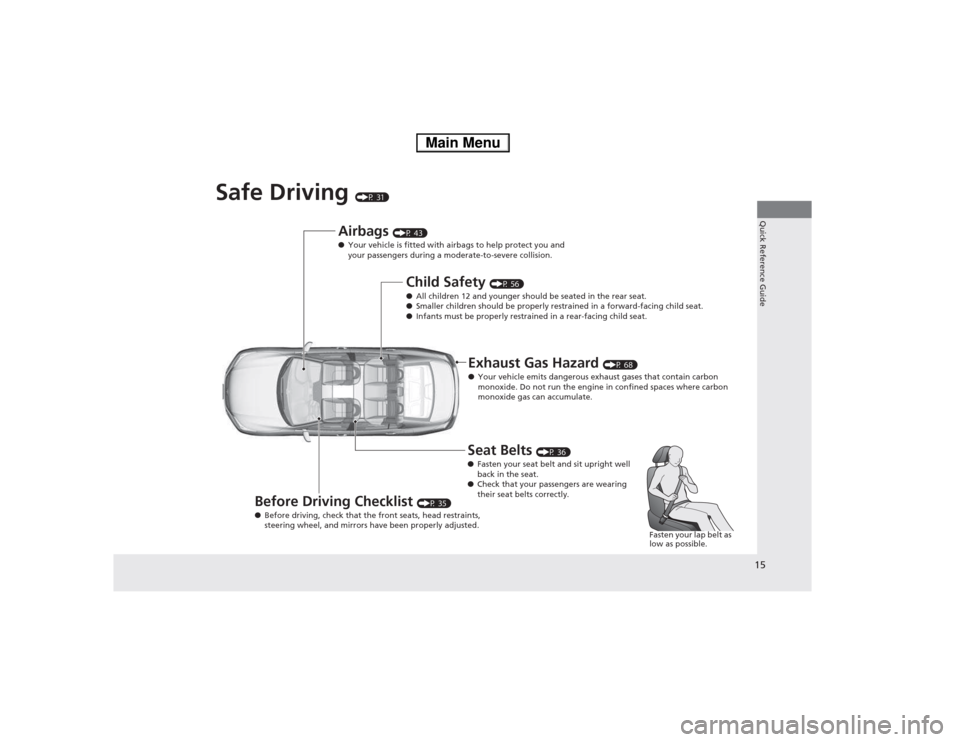
15
Quick Reference Guide
Safe Driving (P 31)
Airbags (P 43)
● Your vehicle is fitted with airbags to help protect you and
your passengers during a moderate-to-severe collision.
Child Safety (P 56)
● All children 12 and younger should be seated in the rear seat.
● Smaller children should be properly restrained in a forward-facing child seat.
● Infants must be proper ly restrained in a rear-facing child seat.
Exhaust Gas Hazard (P 68)
● Your vehicle emits dangerous exhaust gases that contain carbon
monoxide. Do not run the engine in confined spaces where carbon
monoxide gas can accumulate.
Before Driving Checklist (P 35)
● Before driving, check that the front seats, head restraints,
steering wheel, and mirrors have been properly adjusted. Seat Belts
(P 36)
● Fasten your seat belt and sit upright well
back in the seat.
● Check that your passengers are wearing
their seat belts correctly.
Fasten your lap belt as
low as possible.
Main Menu
Page 17 of 561
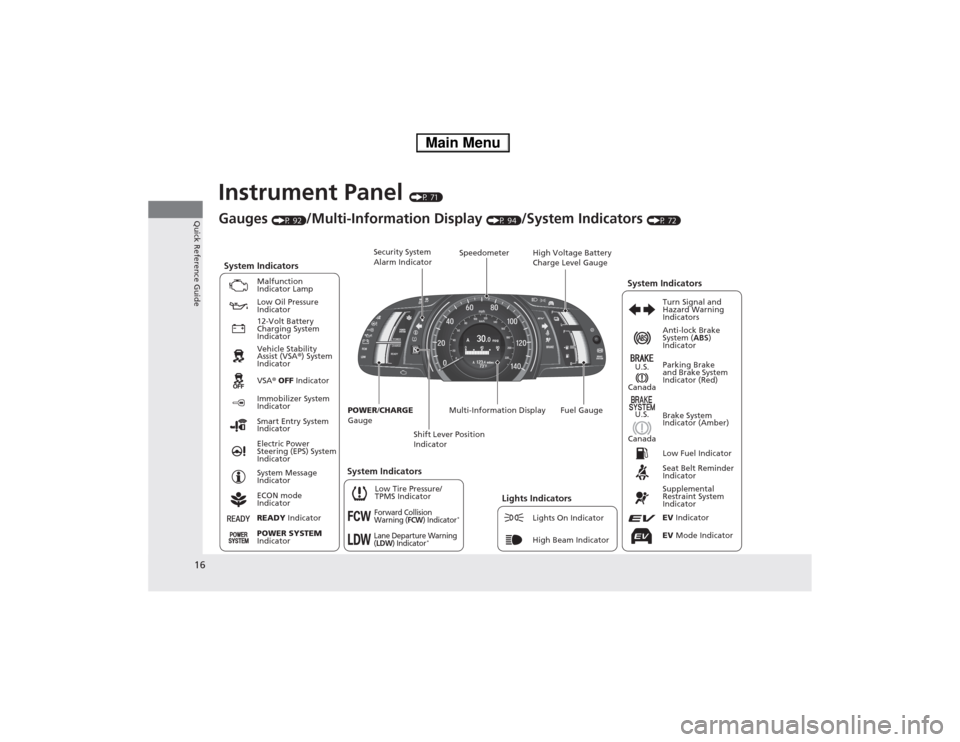
16
Quick Reference Guide
Instrument Panel (P 71)
CanadaU.S.
Low Fuel Indicator
Anti-lock Brake
System ( ABS)
Indicator
Parking Brake
and Brake System
Indicator (Red)
Canada U.S.
READY Indicator
System Indicators
Malfunction
Indicator Lamp
Low Oil Pressure
Indicator
12-Volt Battery
Charging System
Indicator
Vehicle Stability
Assist (VSA ®) System
Indicator VSA ® OFF Indicator
Low Tire Pressure/
TPMS Indicator
Electric Power
Steering (EPS) System
Indicator
Lights IndicatorsLights On Indicator
High Beam Indicator
Immobilizer System
Indicator
Seat Belt Reminder
Indicator EV Indicator
POWER
/CHARGE
Gauge Speedometer
Fuel Gauge
Security System
Alarm Indicator
Shift Lever Position
Indicator
Gauges
(P 92)/Multi-Information Display (P 94)/System Indicators (P 72)
Turn Signal and
Hazard Warning
Indicators
System Indicators High Voltage Battery
Charge Level Gauge
POWER SYSTEM
Indicator
Smart Entry System
Indicator System Message
Indicator
ECON mode
Indicator
Forward Collision
Warning (FCW) Indicator*
Lane Departure Warning (LDW) Indicator* Brake System
Indicator (Amber)
Supplemental
Restraint System
IndicatorEV
Mode Indicator
System Indicators
Multi-Information Display
Main Menu
Page 18 of 561
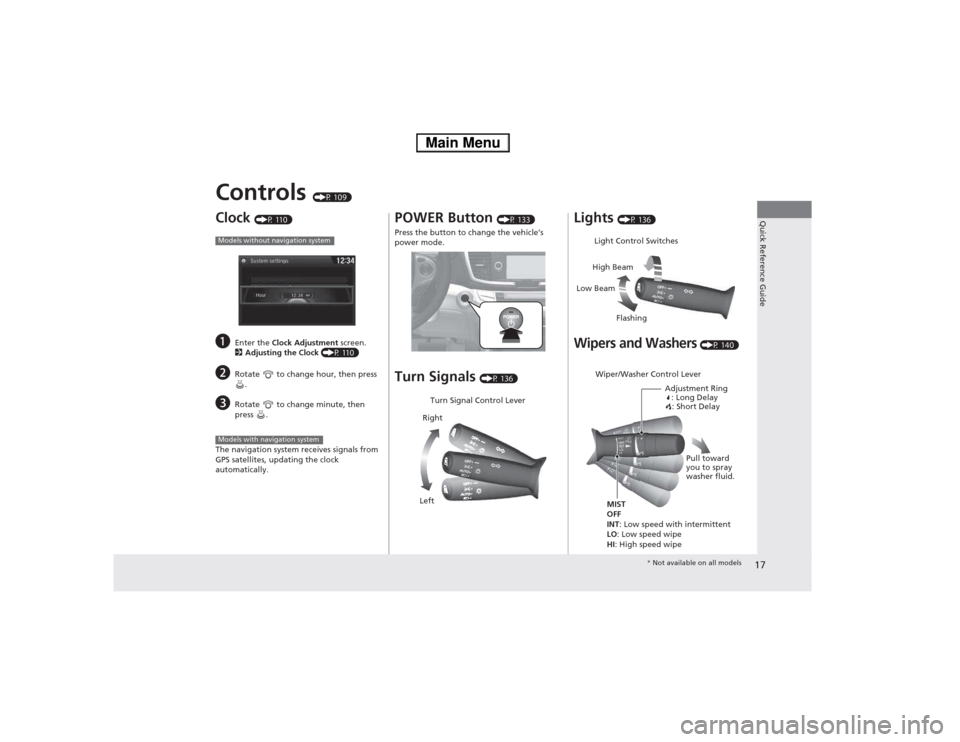
17
Quick Reference Guide
Controls (P 109)
Clock (P 110)
a Enter the Clock Adjustment screen.
2 Adjusting the Clock (P 110)
b Rotate to change hour, then press
.
c Rotate to change minute, then
press .
The navigation system receives signals from
GPS satellites, updating the clock automatically.
Models without navigation system
Models with navigation system
POWER Button (P 133)
Press the button to change the vehicle’s
power mode. Turn Signals (P 136)
Turn Signal Control Lever
Right
Left Lights
(P 136)
Wipers and Washers (P 140)
Light Control Switches
Low Beam High Beam
Flashing
Wiper/Washer Control Lever Adjustment Ring: Long Delay: Short Delay
MIST OFF
INT : Low speed with intermittent
LO : Low speed wipe
HI : High speed wipe Pull toward
you to spray
washer fluid.
*
Not available on all models
Main Menu
Page 19 of 561
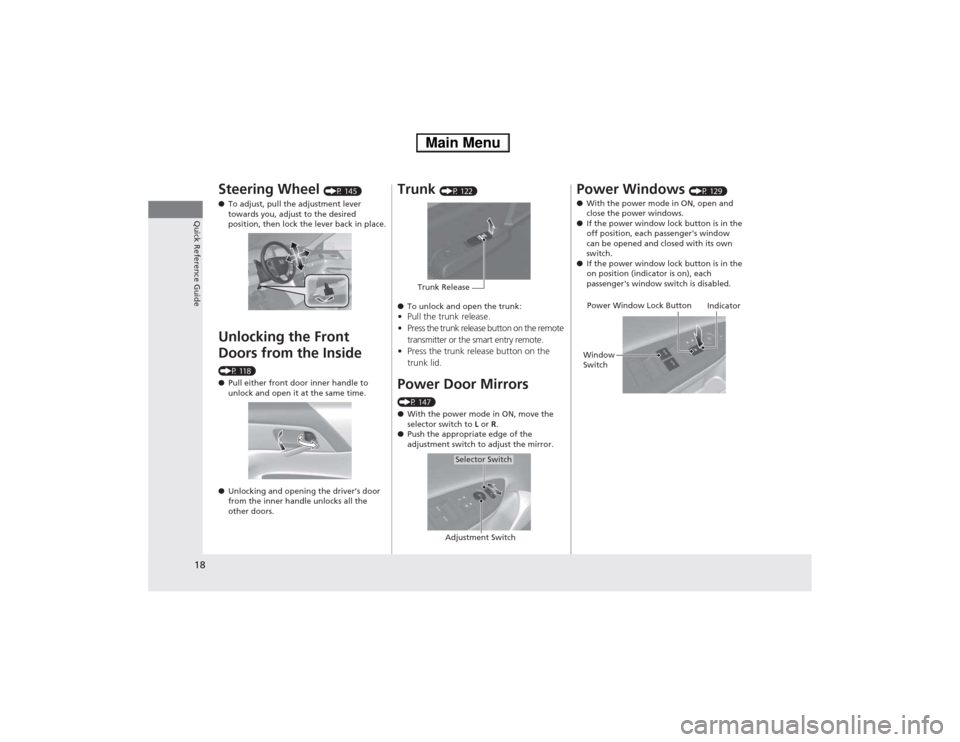
18
Quick Reference Guide
Steering Wheel (P 145)
● To adjust, pull the adjustment lever
towards you, adjust to the desired
position, then lock the lever back in place.
Unlocking the Front Doors from the Inside
(P 118) ● Pull either front door inner handle to
unlock and open it at the same time.
● Unlocking and opening the driver’s door
from the inner handle unlocks all the
other doors.Trunk (P 122)
● To unlock and open the trunk:
• Pull the trunk release.
• Press the trunk release button on the remote
transmitter or the smart entry remote.
• Press the trunk release button on the trunk lid.
Power Door Mirrors
(P 147) ● With the power mode in ON, move the
selector switch to L or R.
● Push the appropriate edge of the
adjustment switch to adjust the mirror.
Trunk Release
Selector Switch
Adjustment Switch
Power Windows (P 129)
● With the power mode in ON, open and
close the power windows.
● If the power window lock button is in the
off position, each passenger's window
can be opened and closed with its own
switch.
● If the power window lock button is in the
on position (indicator is on), each
passenger's window switch is disabled.
Power Window Lock Button
Window
Switch Indicator
Main Menu
Page 20 of 561
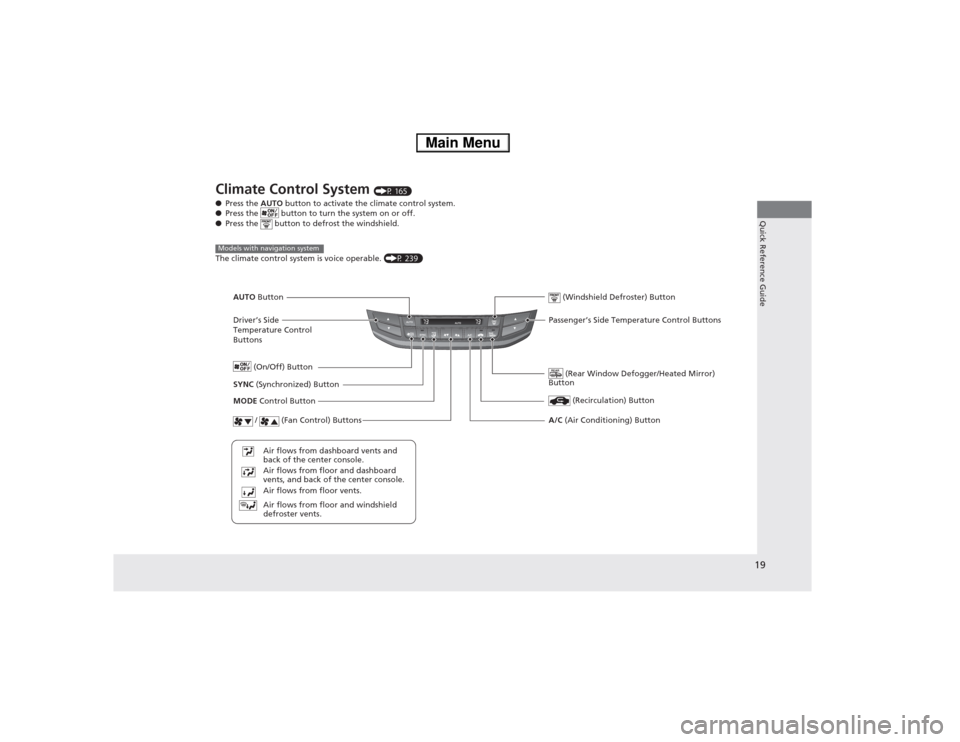
19
Quick Reference Guide
Climate Control System (P 165)
● Press the AUTO button to activate the climate control system.
● Press the button to turn the system on or off.
● Press the button to defrost the windshield.
The climate control system is voice operable. (P 239)
Models with navigation system
Driver’s Side
Temperature Control
Buttons
(Rear Window Defogger/Heated Mirror)
Button
(Windshield Defroster) Button
SYNC (Synchronized) Button
Air flows from floor and windshield
defroster vents.
Air flows from floor vents.
Air flows from floor and dashboard
vents, and back of the center console.
Air flows from dashboard vents and
back of the center console.
AUTO
Button
(On/Off) Button
(Recirculation) ButtonMODE Control Button
/ (Fan Control) Buttons
A/C (Air Conditioning) Button
Passenger’s Side Temperature Control Buttons
Main Menu